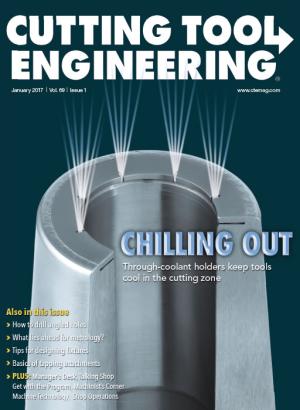We called them “submarines.” Tough, 17-4 PH stainless steel forgings shaped like miniature German U-boats, each requiring several ¼" (6.4mm) through-holes to be drilled at a 25° angle. Each sub was loaded into a jig that held it at the required angle, and a metal plate fitted with hardened steel bushings was then clamped to the top of the jig before the holes were produced with a drill press.
Chips and cutting fluid flew everywhere. And because the drill would occasionally shatter on breakthrough, shrapnel was always a concern. It was mindless, tiring work, and there was an unspoken rule that all new employees had to spend their first week drilling submarines, upon which they could graduate to one of the NC mills or chuckers.

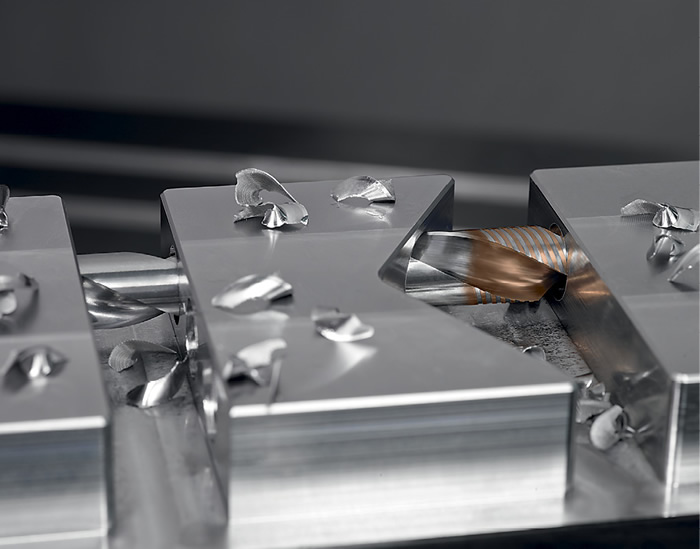
Image courtesy Walter USA.

A Light Touch
Even today, a drill press with a bushed fixture is a cost-effective way to make large numbers of holes, especially when they are not perpendicular to the workpiece surface. That’s because the bushing supports the drill, preventing deflection as it enters the workpiece, and the ability to feel the drill when it breaks through allows an operator to
manually reduce drilling pressure, hopefully avoiding breakage.
That’s certainly the hope of Dave Fagan, shop foreman at Washington Machine Works, a Seattle job shop that specializes in low-volume, complex parts for the nuclear, marine and other industries. Fagan said the quantities at WMW are small enough that bushed drill jigs are rarely necessary. Instead, machinists rely on their sense of touch to guide drills during angled holemaking.
“A lot of our work is done on a Bridgeport,” he said. “It gives you a certain sense of touch, something you don’t feel on a big horizontal boring mill or other large manual machine, where much more iron is moved when you turn the handles.”

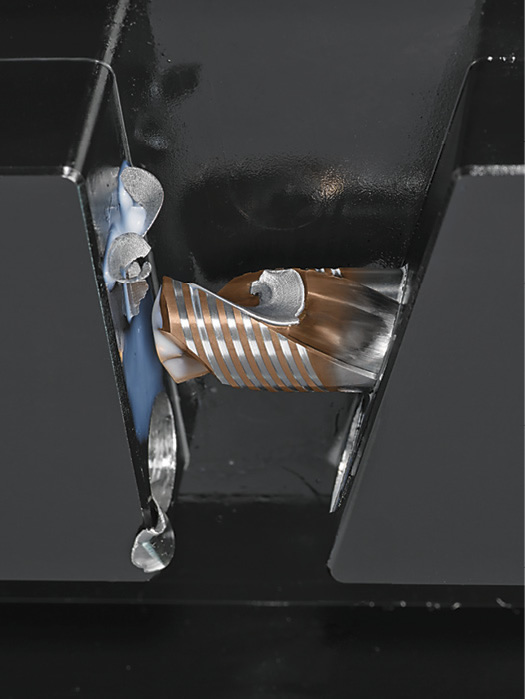
The flute design of the Walter DC170 drill creates support around the periphery of the tool to prevent chatter and drill walking when making angled holes, according to the company. Image courtesy Walter USA.

One job that needed a delicate touch was a 316 stainless axle shaft for a cable drum. Fagan said WMW straddle-clamped the shaft directly to the Bridgeport table, tipped the head 45°, found the centerline and then spotfaced a small flat with an endmill at the required location. Next, a HSS jobber drill was applied to punch through to a cross-hole, into which a length of cable would later be fed.
“There are different ways to go about it,” Fagan said. “You could just as easily tip the part to the required angle with some sine blocks. What’s important is that you do the math and get the hole in the right spot. And you need a good feel for the drill as it breaks through, because it can catch and break. That’s why we like to use HSS, since it’s a lot more forgiving than carbide.”

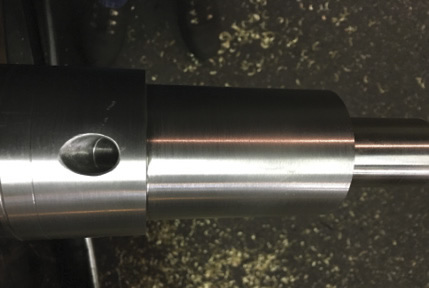
The angled hole on this shaft required a delicate touch while being drilled on a knee mill. Image courtesy Washington Machine Works.

Maximizing Margins
Luke Pollock, product manager at Walter USA LLC, Waukesha, Wis., said that regardless of the machine tool, one of the best solutions for angled holemaking is a four-margin drill. “A drill with two margins per cutting edge provides more contact between the tool and the workpiece material,” he said. “It helps guide the tool and prevents drill walk, especially as you break through the back of the part.”
For relatively shallow holes where the centerline is close to perpendicular, it’s often possible to drill without a starter hole.
“I wouldn’t do that on very tough materials or where high positional accuracy is required, but on depth-to-diameter ratios up to maybe 8:1, you can often just start drilling,” he said. “Another option is our DC170 drill, which, because of its flute design, offers support around the entire periphery of the drill point. It basically acts like a bearing surface, preventing any chatter or drill walk on exit.”
For most angled drilling, Pollock recommends reducing speeds and feeds by 30 to 50 percent when starting and exiting a hole. If a starter hole is required, he said many shops don’t drill one. Instead, they use a center-cutting endmill to create a flat the same size, or slightly larger, than the drill’s diameter. He added that a better option than endmilling a flat is to apply a dedicated pilot drill with a 180° point, because it has greater metal-removal capabilities and improves accuracy and tool life.
Magnetic Personality
An annular cutter is another alternative to a jobber drill when making an angled hole. Also known as a Rotabroach, an annular cutter looks like a hollow endmill. It works by removing a ring of material the same size as the finished hole. The center portion inside of the ring remains intact and is ejected once the cutter is removed from the hole.
Because annular cutters remove only the outer periphery of the hole, horsepower and thrust requirements are far lower than traditional holemaking tools, making annular cutters a favorite for magnetic and hand-held drilling. Yet Allan Powers, technical applications lead at Hougen Manufacturing Inc., Swartz Creek, Mich., said Rotabroaches are a popular holemaking alternative on CNC machines as well, especially when spindle power is limited.

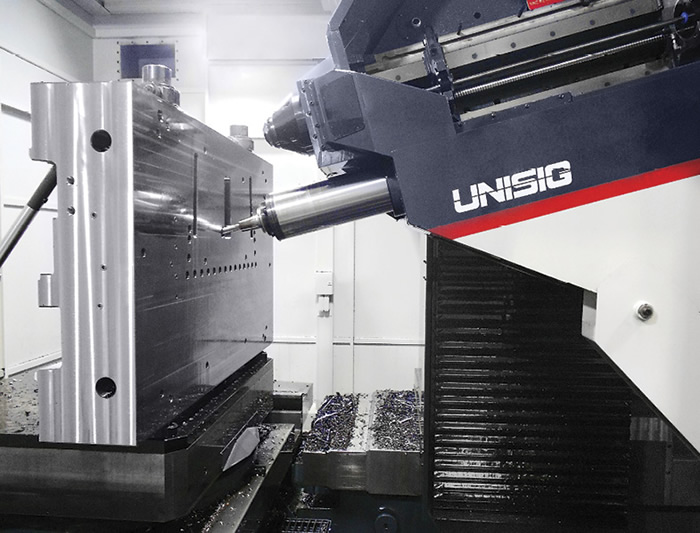
Some angled holes call for complex, compound angles that have matching geometry with other machined features. A drill bushing ground with these special angles is not practical or economical in these cases. Image courtesy Unisig.

“Annular cutters are also effective on angled holes, provided the centerline is no more than 20° from perpendicular,” he said. “Unless it’s soft material, like aluminum, the lateral loads become too great, and you run the risk of breaking the cutter. We recommend reducing feed rates until the cutter is fully engaged, but, because the tool is largely self-supporting, there’s no need to slow down on breakout.”
Powers also recommends using a bushing to support the drill. Contrary to conventional wisdom, however, he suggested it be made of brass or other soft metal and not hardened steel.
“One of our customers had an angled hole application and found that the chips would curl back in and get caught between the steel bushing and the cutter, causing it to bind,” he said. “By switching to brass, they improved chip evacuation and completely eliminated the problem. We’ve since validated their approach with our own in-house testing.”
Hole Accuracy and Burrs
Someone who’s a firm believer in drill bushings—although probably not ones made of brass—is Anthony Fettig, CEO at deep-hole drilling system provider Unisig, Menomonee Falls, Wis. He said the company has “drilled some really strange holes with pretty significant complexity and close tolerances.” His first questions when quoting a job are often: What accuracy is required, and what burr condition is allowed?
Gundrilling relies on a bushing to guide a single-flute, noncenter-cutting drill into the workpiece. This bushing also acts to contain a stream of high-pressure cutting oil. Drilling an angled hole in an automobile crankshaft bearing journal, for example, requires a specially designed bushing with a concave face that conforms to the journal surface. Together with some clever grinding of the drill point, use of wear pads along the drill periphery and the proper application of speeds and feeds, holes can be predictably and accurately gundrilled by the hundreds of thousands.

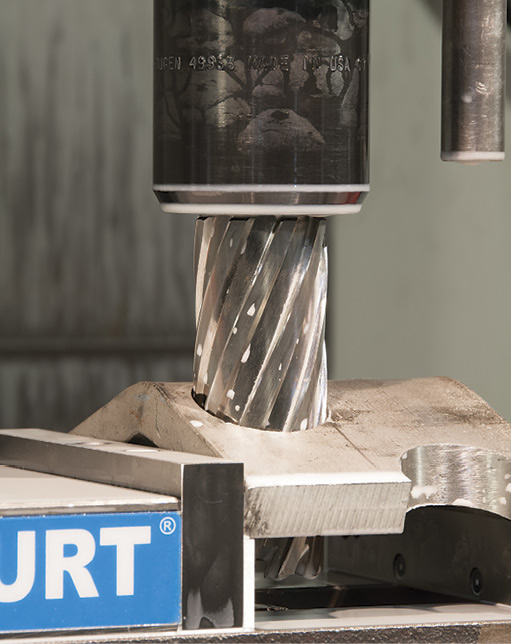
Annular cutters, originally designed for use with manual and magnetic drills, are increasingly used on CNC machine tools. Image courtesy Hougen Manufacturing.

One of the biggest challenges with any angled-holemaking operation, Fettig said, is burr control. Because cutting fluid pressure around the drill tip falls to near zero when a drill breaks through into a cross-hole or out the back of the workpiece, chip evacuation is compromised while heat in the cutting area increases.
Second, even specialty drills like the ones used in high-volume gundrilling are unable to cut effectively with only one side of the tool engaged, as this creates nonuniform drilling forces. The result is that workpiece material tends to extrude rather than shear, and a larger than normal burr is formed.

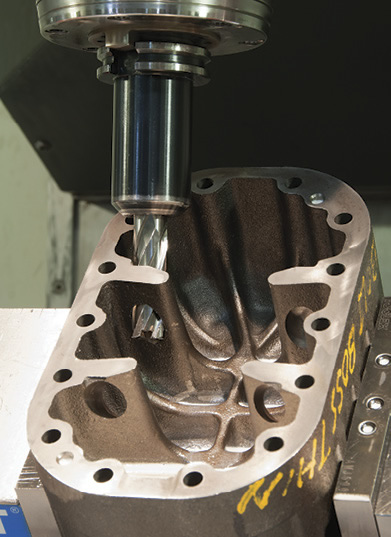
Holemaking up to 20° from perpendicular is the rule of thumb for most annular-cutting operations. Image courtesy Hougen Manufacturing.

Another common problem, Fettig said, is inspecting intersecting holes, such as those seen in injection molds and a large number of automotive components.
“When you’re drilling a pair of holes 0.080" in diameter that intersect 4" to 6" inside the part, there’s no real way to inspect them accurately,” Fettig said. “A CMM does a good job of projecting where the holes should meet, but there may have been some drill walk or deflection along the way. About the best you can do is use a borescope to inspect the hole intersection.”
Contact Details
Contact Details
Contact Details
Related Glossary Terms
- boring
boring
Enlarging a hole that already has been drilled or cored. Generally, it is an operation of truing the previously drilled hole with a single-point, lathe-type tool. Boring is essentially internal turning, in that usually a single-point cutting tool forms the internal shape. Some tools are available with two cutting edges to balance cutting forces.
- burr
burr
Stringy portions of material formed on workpiece edges during machining. Often sharp. Can be removed with hand files, abrasive wheels or belts, wire wheels, abrasive-fiber brushes, waterjet equipment or other methods.
- bushing
bushing
Cylindrical sleeve, typically made from high-grade tool steel, inserted into a jig fixture to guide cutting tools. There are three main types: renewable, used in liners that in turn are installed in the jig; press-fit, installed directly in the jig for short production runs; and liner (or master), installed permanently in a jig to receive renewable bushing.
- chatter
chatter
Condition of vibration involving the machine, workpiece and cutting tool. Once this condition arises, it is often self-sustaining until the problem is corrected. Chatter can be identified when lines or grooves appear at regular intervals in the workpiece. These lines or grooves are caused by the teeth of the cutter as they vibrate in and out of the workpiece and their spacing depends on the frequency of vibration.
- computer numerical control ( CNC)
computer numerical control ( CNC)
Microprocessor-based controller dedicated to a machine tool that permits the creation or modification of parts. Programmed numerical control activates the machine’s servos and spindle drives and controls the various machining operations. See DNC, direct numerical control; NC, numerical control.
- cutting fluid
cutting fluid
Liquid used to improve workpiece machinability, enhance tool life, flush out chips and machining debris, and cool the workpiece and tool. Three basic types are: straight oils; soluble oils, which emulsify in water; and synthetic fluids, which are water-based chemical solutions having no oil. See coolant; semisynthetic cutting fluid; soluble-oil cutting fluid; synthetic cutting fluid.
- drilling machine ( drill press)
drilling machine ( drill press)
Machine designed to rotate end-cutting tools. Can also be used for reaming, tapping, countersinking, counterboring, spotfacing and boring.
- endmill
endmill
Milling cutter held by its shank that cuts on its periphery and, if so configured, on its free end. Takes a variety of shapes (single- and double-end, roughing, ballnose and cup-end) and sizes (stub, medium, long and extra-long). Also comes with differing numbers of flutes.
- endmilling
endmilling
Operation in which the cutter is mounted on the machine’s spindle rather than on an arbor. Commonly associated with facing operations on a milling machine.
- feed
feed
Rate of change of position of the tool as a whole, relative to the workpiece while cutting.
- fixture
fixture
Device, often made in-house, that holds a specific workpiece. See jig; modular fixturing.
- flat ( screw flat)
flat ( screw flat)
Flat surface machined into the shank of a cutting tool for enhanced holding of the tool.
- grinding
grinding
Machining operation in which material is removed from the workpiece by a powered abrasive wheel, stone, belt, paste, sheet, compound, slurry, etc. Takes various forms: surface grinding (creates flat and/or squared surfaces); cylindrical grinding (for external cylindrical and tapered shapes, fillets, undercuts, etc.); centerless grinding; chamfering; thread and form grinding; tool and cutter grinding; offhand grinding; lapping and polishing (grinding with extremely fine grits to create ultrasmooth surfaces); honing; and disc grinding.
- gundrilling
gundrilling
Drilling process using a self-guiding tool to produce deep, precise holes. High-pressure coolant is fed to the cutting area, usually through the gundrill’s shank.
- high-speed steels ( HSS)
high-speed steels ( HSS)
Available in two major types: tungsten high-speed steels (designated by letter T having tungsten as the principal alloying element) and molybdenum high-speed steels (designated by letter M having molybdenum as the principal alloying element). The type T high-speed steels containing cobalt have higher wear resistance and greater red (hot) hardness, withstanding cutting temperature up to 1,100º F (590º C). The type T steels are used to fabricate metalcutting tools (milling cutters, drills, reamers and taps), woodworking tools, various types of punches and dies, ball and roller bearings. The type M steels are used for cutting tools and various types of dies.
- jig
jig
Tooling usually considered to be a stationary apparatus. A jig assists in the assembly or manufacture of a part or device. It holds the workpiece while guiding the cutting tool with a bushing. A jig used in subassembly or final assembly might provide assembly aids such as alignments and adjustments. See fixture.
- milling machine ( mill)
milling machine ( mill)
Runs endmills and arbor-mounted milling cutters. Features include a head with a spindle that drives the cutters; a column, knee and table that provide motion in the three Cartesian axes; and a base that supports the components and houses the cutting-fluid pump and reservoir. The work is mounted on the table and fed into the rotating cutter or endmill to accomplish the milling steps; vertical milling machines also feed endmills into the work by means of a spindle-mounted quill. Models range from small manual machines to big bed-type and duplex mills. All take one of three basic forms: vertical, horizontal or convertible horizontal/vertical. Vertical machines may be knee-type (the table is mounted on a knee that can be elevated) or bed-type (the table is securely supported and only moves horizontally). In general, horizontal machines are bigger and more powerful, while vertical machines are lighter but more versatile and easier to set up and operate.
- numerical control ( NC)
numerical control ( NC)
Any controlled equipment that allows an operator to program its movement by entering a series of coded numbers and symbols. See CNC, computer numerical control; DNC, direct numerical control.
Contributors
Hougen Manufacturing Inc.
(800) 426-7818
www.hougen.com
Unisig
(262) 252-3802
www.unisig.com
Walter USA LLC
(800) 945-5554
www.walter-tools.com/us
Washington Machine Works
(206) 767-2688
www.washingtonmachineworks.com




